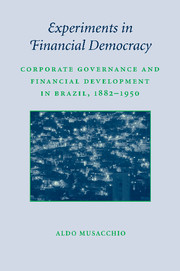 Experiments in Financial Democracy
Experiments in Financial Democracy Book contents
- Frontmatter
- Contents
- List of Figures and Tables
- Preface
- Acknowledgments
- 1 Introduction
- 2 Financial Development in Brazil in the Nineteenth Century
- 3 The Stock Exchange and the Early Industrialization of Brazil, 1882–1930
- 4 The Foundations of Financial Democracy: Disclosure Laws and Shareholder Protections in Corporate Bylaws
- 5 Voting Rights, Government Guarantees, and Ownership Concentration, 1890–1950
- 6 Directors, Corporate Governance, and Executive Compensation in Brazil, c. 1909
- 7 Bond Markets and Creditor Rights in Brazil, 1850–1945
- 8 Were Bankers Acting as Market Makers?
- 9 What Went Wrong after World War I?
- 10 The Rise of Concentrated Ownership in the Twentieth Century
- 11 Conclusion
- Bibliography
- Index
- STUDIES IN MACROECONOMIC HISTORY
7 - Bond Markets and Creditor Rights in Brazil, 1850–1945
Published online by Cambridge University Press: 30 January 2010
- Frontmatter
- Contents
- List of Figures and Tables
- Preface
- Acknowledgments
- 1 Introduction
- 2 Financial Development in Brazil in the Nineteenth Century
- 3 The Stock Exchange and the Early Industrialization of Brazil, 1882–1930
- 4 The Foundations of Financial Democracy: Disclosure Laws and Shareholder Protections in Corporate Bylaws
- 5 Voting Rights, Government Guarantees, and Ownership Concentration, 1890–1950
- 6 Directors, Corporate Governance, and Executive Compensation in Brazil, c. 1909
- 7 Bond Markets and Creditor Rights in Brazil, 1850–1945
- 8 Were Bankers Acting as Market Makers?
- 9 What Went Wrong after World War I?
- 10 The Rise of Concentrated Ownership in the Twentieth Century
- 11 Conclusion
- Bibliography
- Index
- STUDIES IN MACROECONOMIC HISTORY
Summary
Corporate bond markets in Brazil grew to historical levels at the same time stock markets peaked. This chapter shows that the development of corporate bond markets was, to a large extent, linked to the protections for creditors in national bankruptcy laws. This chapter discusses the importance of the bond market and explains the evolution of the protections for creditors both on paper and by the courts between 1850 and 1945.
Beyond sheer size relative to GDP, the scale of development of Brazil's bond markets before 1920 is impressive in two respects. First, corporations in all sectors of the economy issued bonds to obtain funds. In fact, bond markets were among the most important sources of new funds for corporations (issuing companies secured approximately 30% of their capital through this channel). Second, the scale of Brazil's bond markets relative to the size of Brazil's economy suggests that a strong formal institutional system was in place to enforce bondholder rights (e.g., in the event of bankruptcy).
But although size should attest to the existence of an institutional framework for protecting creditors, the strength of creditor protections was called into question by research such as Gail Triner's influential study of Brazilian banking. Arguing that the “insufficient protection for the recovery of debt was a serious problem throughout the First Republic [1889–1930],” Triner maintained that the main problem for banks trying to recover unpaid debts was that “the laws and Commercial Code simply did not address issues involving financial property,” making it difficult for them to take possession of debtors' bank accounts and other financial assets.
- Type
- Chapter
- Information
- Experiments in Financial DemocracyCorporate Governance and Financial Development in Brazil, 1882–1950, pp. 155 - 185Publisher: Cambridge University PressPrint publication year: 2009


